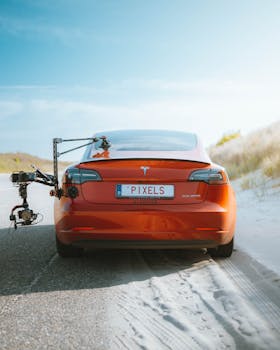
A secret project shrouded in mystery, billions spent, yet nothing to show. What went wrong with Apple's ambitious car plans? We delve into the reasons behind Apple's decision to abandon its decade-long electric vehicle project, examining the challenges, internal conflicts, and shifting market dynamics that led to its downfall.
Apple Car's Crash: Why the Tech Giant Abandoned Its Automotive Dream
A secret project shrouded in mystery, billions spent, yet nothing to show. What went wrong with Apple's ambitious car plans? We delve into the reasons behind Apple's decision to abandon its decade-long electric vehicle project, examining the challenges, internal conflicts, and shifting market dynamics that led to its downfall.
Introduction
For nearly a decade, rumors swirled around Apple's clandestine automotive ambitions. Project Titan, as it was internally known, promised a revolutionary electric vehicle, a self-driving marvel that would redefine transportation. Billions of dollars were poured into research and development, attracting top talent from Tesla, Ford, and other automotive giants. Yet, in early 2024, the dream abruptly ended. Apple officially pulled the plug, reassigning its car team to focus on artificial intelligence and generative AI projects. What caused this dramatic U-turn? Was it a lack of technical prowess, a misjudgment of the automotive market, or simply an unrealistic vision? Let's explore the key factors that contributed to the Apple Car's spectacular crash.
The Road to Nowhere: Technical and Design Hurdles
The Self-Driving Conundrum
Apple's initial vision was a fully autonomous, Level 5 self-driving vehicle – one that required no human intervention whatsoever. This proved to be a monumental challenge. While companies like Waymo have made progress in geofenced areas, achieving true Level 5 autonomy in all conditions remains elusive. Apple struggled to develop reliable and safe self-driving technology, facing numerous setbacks and delays. The complexity of navigating unpredictable real-world scenarios, coupled with regulatory hurdles, proved insurmountable within the project's timeline and budget.
Example: Imagine a sudden snowstorm. A Level 5 autonomous vehicle needs to accurately interpret sensor data, navigate slippery roads, and react safely to unexpected obstacles. This requires immense processing power, sophisticated algorithms, and vast amounts of training data, which proved incredibly difficult to achieve.
Design Conflicts and Shifting Priorities
Beyond the technological challenges, internal disagreements plagued the project. Design teams clashed over the vehicle's aesthetics, functionality, and target market. Should it be a sleek, minimalist pod focused solely on autonomous driving, or a more conventional car with advanced driver-assistance systems (ADAS)? These conflicting visions led to constant revisions and hampered progress.
Tip: Clear communication and a unified vision are crucial for any large-scale project. Apple's internal conflicts highlight the importance of aligning design and engineering teams around a common goal.
Battery Technology Limitations
Developing a cutting-edge battery technology was also a key objective. Apple reportedly explored innovative battery designs, aiming for increased energy density, faster charging times, and improved safety. However, breakthroughs in battery technology are notoriously difficult to achieve, and Apple faced limitations in this area. The inability to secure a significant advantage in battery performance further undermined the project's competitiveness.
Market Realities and Shifting Sands
Intense Competition and Razor-Thin Margins
The automotive industry is fiercely competitive, with established players like Tesla, Toyota, and General Motors vying for market share. Electric vehicles are becoming increasingly commoditized, and profit margins are often razor-thin. Apple, accustomed to high-margin hardware and software sales, may have underestimated the challenges of competing in this demanding market.
Example: Tesla, despite its success, has faced numerous production challenges and profitability concerns. Entering this market as a newcomer, with no existing manufacturing infrastructure, would have been a significant undertaking for Apple.
Regulatory Hurdles and Safety Concerns
The automotive industry is heavily regulated, with stringent safety standards and emissions requirements. Obtaining regulatory approval for a fully autonomous vehicle is a complex and time-consuming process. Apple faced scrutiny from regulators and safety advocates, who raised concerns about the safety and reliability of its self-driving technology. These regulatory hurdles added further delays and uncertainties to the project.
Shifting Consumer Preferences
Consumer preferences in the automotive market are constantly evolving. While there is growing demand for electric vehicles, many consumers are still hesitant to embrace fully autonomous driving. Apple may have misjudged the pace of adoption for self-driving technology, leading to a mismatch between its vision and market realities.
The Pivot to AI: A Strategic Retreat?
Ultimately, Apple's decision to abandon the car project reflects a strategic reassessment of its priorities. The company is now focusing on artificial intelligence and generative AI, technologies that have the potential to transform its existing product lines and create new revenue streams. By reassigning its car team to AI projects, Apple is betting that it can achieve greater success and generate higher returns in a different area.
Tip: Companies must be willing to adapt to changing market conditions and reallocate resources to areas with the greatest potential for growth. Apple's pivot to AI demonstrates the importance of strategic flexibility.
Conclusion
The Apple Car's demise is a cautionary tale about the challenges of entering a complex and competitive industry. Technical hurdles, internal conflicts, market realities, and shifting consumer preferences all contributed to the project's downfall. While Apple's automotive dream may be over, the company's foray into the electric vehicle market has undoubtedly left its mark, pushing the boundaries of innovation and inspiring other tech giants to explore the future of transportation. The resources and talent acquired during the Apple Car project now shift to AI development, a move that could reshape Apple's future in ways we can only begin to imagine.
